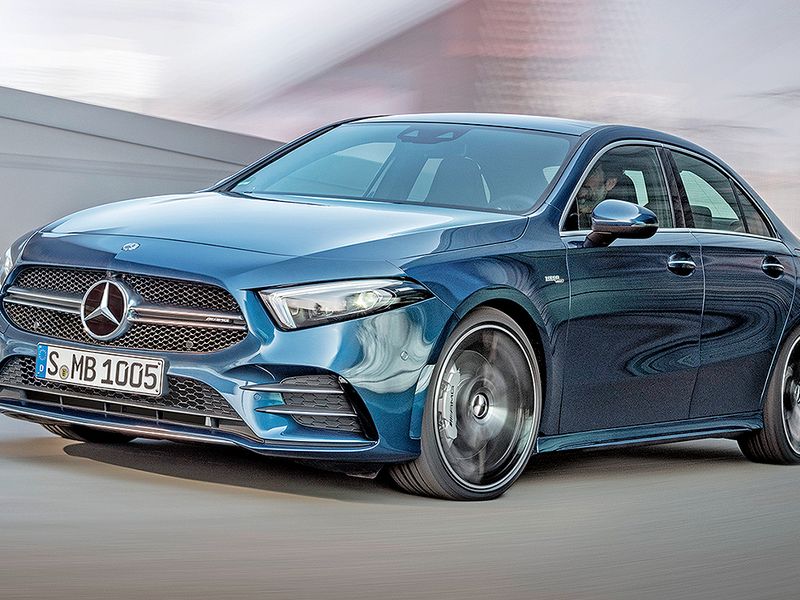
Two years ago, Daimler kicked off production of its newest U.S. model — the millennial-targeted Mercedes-Benz A-Class — at its $1 billion joint-venture factory with Nissan in Aguascalientes, Mexico.
Now Mercedes has reversed course and is shipping production of the compact sedan back to its plant in Rastatt, Germany, supply chain and dealer sources told Automotive News.
Mercedes’ focus at the Mexico assembly plant, known as COMPAS, is now the GLB, a compact crossover that launched in the U.S. last year.
In a communication with A-Class suppliers this month, obtained by Automotive News, Daimler said: “The current dynamic development of the automotive market under the influence of the pandemic requires constant monitoring and adjustment of production strategies.
“Therefore, we have decided to focus on the X247 [GLB] project at COMPAS and discontinue the V177 [A-Class] production in Mexico.”
A Daimler spokesman late last week confirmed the production move from Mexico, saying the decision will give Mercedes additional capacity for crossovers.But the production shuffle suggests an expensive miscalculation by Daimler on America’s appetite for compact sedans.
At the end of 2015, when Daimler would have been orchestrating the North American production plan, compact sedans made up 12.7 percent of the total light-vehicle market in the U.S. That market share was down to 8.4 percent last year.
“I think Mercedes misread the market and underestimated just how badly demand for small luxury sedans would fall,” AutoPacific analyst Ed Kim said.
It’s unusual to reverse course on a major manufacturing program in just two years, noted Jeff Schuster, president of global forecasting at LMC Automotive.
“There’s cost involved in doing that,” Schuster said. “There’s sunk cost in tooling, training and configuration of the line.”
The production pullback also shines a spotlight on the new and underutilized Daimler-Nissan assembly plant in central Mexico. The factory, which launched in late 2017, last year built 90,408 vehicles — or less than 40 percent of its more than 230,000-vehicle capacity.
In addition to the Mercedes models, the 3 million-square-foot Aguascalientes factory builds Infiniti’s QX50 and QX55 crossovers. But the QX55, a new model, has suffered production delays, pushing its planned U.S. launch to next year. And plans for an unidentified luxury compact vehicle that was to be co-developed by Daimler and Infiniti and built at the factory have been scrapped, as consumer tastes have migrated to more practical crossovers.
Automotive News reported more than a year ago that Mercedes also planned to pull C-Class production out of its plant in Vance, Ala., to make room for utility vehicles.
That consumer trend also is driving Mercedes to shift its capacity from the A-Class to the GLB, analysts said. The luxury compact-sedan segment’s share of the U.S. light-vehicle market was 1.9 percent last year, tumbling nearly 40 percent since the end of 2015.
There is less benefit for Mercedes to tie up production with an entry-level sedan, especially in a market that’s moving toward crossovers, noted Sam Fiorani, vice president at AutoForecast Solutions.
“Production of the GLB crossover is much more important to the company’s bottom line than the A-Class sedan, which couldn’t generate the same kind of revenue,” he said.
According to Fiorani, the Mexico assembly plant had been on pace to build about 96,000 GLBs this year, before the coronavirus pandemic upended production schedules and demand expectations. In comparison, the factory assembled 40,434 A-Class vehicles last year.
The A-Class, featured in Mercedes’ Super Bowl ad last year, was marketed as a millennial vehicle that would bring Mercedes a new generation of customers.
But the sedan arrived in U.S. stores later than expected, and it struggled to differentiate from the CLA sedan, dealers said. Mercedes sold 17,641 A-Class sedans last year.
Mercedes had doubts about the viability of a small sedan in the U.S. from the start.
The automaker initially hesitated to bring the A-Class to the U.S. because of its small size, former Mercedes-Benz USA CEO Dietmar Exler said in 2018, before its launch. But the success of the CLA showed that U.S. consumers would embrace a smaller sedan.
A Mercedes dealer questioned the wisdom of having two compact sedans in a shrinking market. Having both the A-Class and CLA in the U.S. “seems a little excessive,” said the dealer, who requested he not be identified.
“Mercedes still wants to have an entry-level model on the passenger-car side,” he said. “But for there to be both of those is a little bit of a head-scratcher.”
It is unclear how long Mercedes intends to keep selling the low-volume A-Class in the U.S. market as an import from Germany. Higher labor costs and trade tariffs no doubt will put pressure on the model’s low-$30,000 sticker price.
Even so, keeping it around makes sense if it helps draw new — and younger — customers to the brand.
“There are certain models in every automaker’s lineup where they know they are losing money, but feel they need strategically to be in the segment,” Kim said.
Efficiency gains from consolidating production in Europe, where the volume is centered, could help offset import-related costs for U.S. retailers.
The relocation should push utilization at the Rastatt plant to more than 95 percent, Schuster said.
Given the limited U.S. demand, he said, Mercedes should be able to absorb the cost of importing the A-Class.